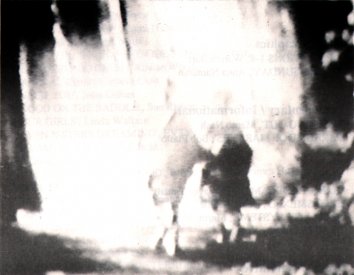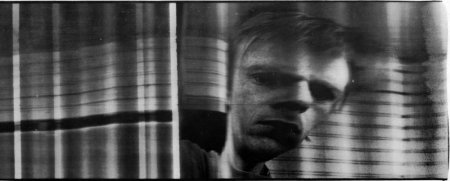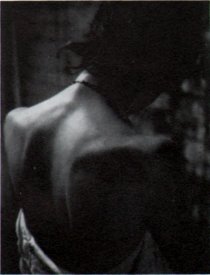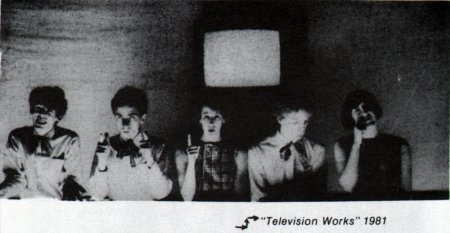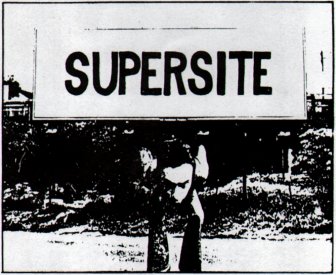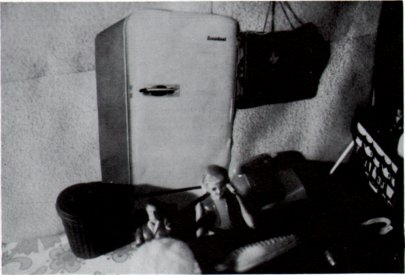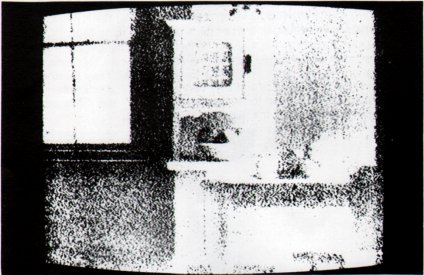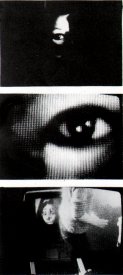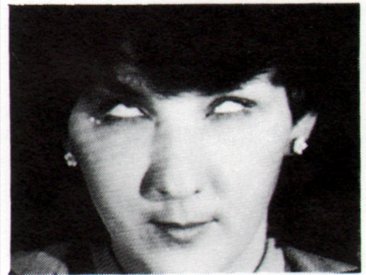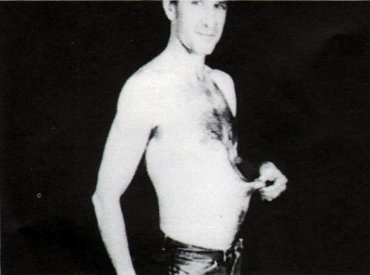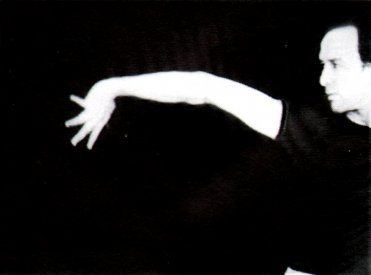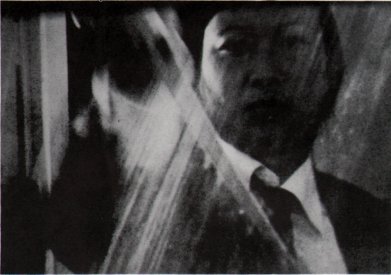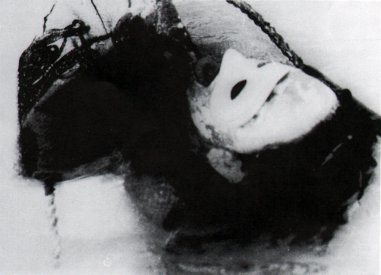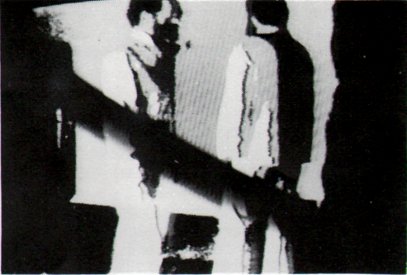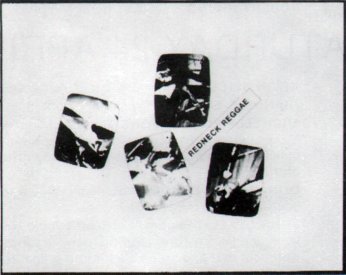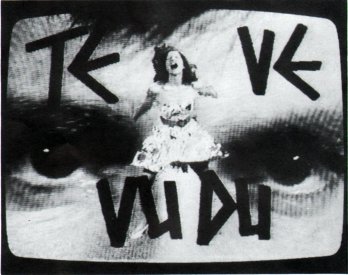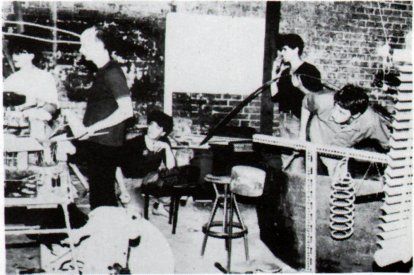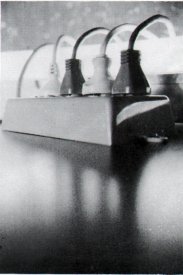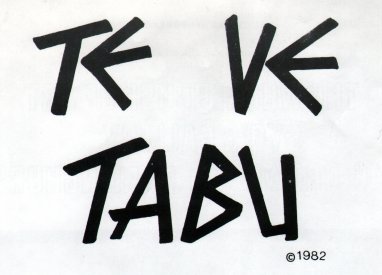Te Ve Tabu is the second national annual exhibition of artists' work in 'post object' art mediums to be organised by CREATIVE SPACE as part of the Studio Access Project. Represented is a current, and partially retrospective, collection of work in the mediums of Super 8 film, video, audio, audio-visual, and video-performance.
Although most of these media are familiar to everyone in their commercial, industrial, and domestic applications, familiarity has in most cases bred complacency, rather than contempt, for the power these methods of communication have over our lives.
Video and Super 8 film alike are still relatively new mediums in their 'artistic' adaptations - neither is yet twenty years old in this sense - however like woodblock, copperplate engraving, lithographic and screen printing before them, these image-making technologies originally conceived for "mass" consumption are finding interesting 'tangential' applications in the hands of creative individuals or small like-minded groups.
Television has always been, despite its bland portrayal by the networks, a basically private medium anyway. All of us tend to 'watch' it amongst the informal domestic arrangements, both of paraphernalia and personalities, which we gather around ourselves: to many who have not before seen TV presented 'publicly' in a formal manner this exhibition will offer some surprises - not so much because a lot of the material is 'personal', both in its subject matter and means of production, as because it will be presented in a way with which we are familiar only in the cinema.
It has always surprised me that individual attempts to come to terms with mediums like video, outside the incongruous guidelines offered by commercial television, have been subjected to so much cynicism and contempt. It is interesting that we feel far more cheated of our time and apparent freedom when our fear of, or irritation with 'boredom' is fostered by an individual rather than by a large corporation: in our homes we will watch a 'boring' program simply for the sake of watching anything. The arena of video art doesn't seem to proffer so much complacency and in many ways it is fortunate that its audience doesn't have so much bogus patience.
Well, we are still learning, even if it is at the expense of our own very relative freedom. This technology, like any other, should never be treated as an end in itself.
It is appropriate that METRO TELEVISION should host this second new media exhibition. Video art in particular suffers from a lack of public exposure in Australia and METRO's commitment to the future establishment of Public Television in Sydney makes it the logical venue to familiarise both the public and the future programmers of PTV with this little known but pertinent area of video.
Not all the work presented in Te Ve Tabu is oriented to television. This exhibition is also attempting to fill a gap in the inconsistent presentation of mediums other than video art, hopefully on an annual basis. Nor is television the only area of presentation that artists working even in video and film are seeking out. However it is timely for some of these artists and students to be looking in the direction of broadcast. Public Television, it is to be hoped, will offer us some more interesting models than those which are so relentlessly recreated by our established television networks.
Te Ve Tabu will in fact be the first in a series of monthly events planned by METRO TELEVISION to explore in detail many of the recent developments in video. These will include an examination of video documentary, new technological aspects of image making systems, the future of public television, video as an alternative medium to film, electronic music on tape, rock video, as well as other aspects of video art not explored in the present project. A major video exposition in all these areas is planned toward the end of this series.
These events will draw emphasis to the applications of electromedia in art and society, both from the viewpoint of technician and producer, as well as in the interests of the community use and enjoyment of these technologies. METRO will be inviting many people working in video throughout Australia, as well as some prominent artists and technological experts from overseas, to participate in this program.
METRO's activities in these areas signify an increasing level of interest in the creative potential of a medium which to date we have used only as a household object in front of which we sit and do nothing.
Although this is likely to be the last Studio Access Project to be organised by Creative Space, Te Ve Tabu has hopefully established a precedent for an annual exhibition in these new media. It may be timely in this respect, that the new Sydney visual arts centre is about to be established.
PETER CALLAS
For information on the upcoming METRO video series ring Michael Griggs 33 5318.
The second national annual exhibition of artists' work in video, film, audio, video-performance, audio-visual, and performance mediums.
Presented in association with METRO TELEVISION.
Monday 19 - Sunday 25 April 1982
at METRO TELEVISION, Oatley Road entrance to Paddington Town Hall, Oxford Street, Paddington. 7pm-10pm nightly. a different program every night.
Entrance $3, concessions $2.7 night subscription $15, subscription concessions $10.
Telephone information: 827 1048/33 5318
Curated & Coordinated by Peter Callas in association with CREATIVE SPACE.
Coordination assisted by Ross Wolfe, Geoffrey Miller, Peter Thorn.
Film Projectionist, Mark Titmarsh.
Acknowledgements:
RANK ELECTRONICS for the loan of a Rank Arena Video Projector
CITY ART INSTITUTE LIBRARY for the loan of several significant historical videotapes (shown free of charge).
SYDNEY COLLEGE OF THE ARTS, METRO TELEVISION LTD, and the CITY ART INSTITUTE, for the loan of video, film and audio equipment.
METRO TELEVISION LTD. for the use of 'Studio 'B' '
This Program is subject to alteration without notice.
PROGRAM ROOM CODE:
(B) METRO TV STUDIOW.
(F) FOYER
(M) MEETING ROOM
MONDAY 19 APRIL:
(F) 6.30 pm
"Video, The New Wave", col.u-matic video, 1973.
A compilation of American video art produced in 1973, including the work of Joan Jonas, Peter Campus, Nam June Paik, & Ed Emshwiller. Half hour excerpt. Courtesy City Art Institute Library.
(B) 7.00pm-7.35pm
DAVID NERLICH, "Captain Willard are you in there?", super 8, 6mins, 1981.
An improvised 'cartoon'.
STEPHEN HARROP, “Iteth Bound to be Bathkervileth", super 8, 4mins, 1981.
A film designed to use long exposure times, using a flashlight as a strobe to create multi-images on each frame. The audio track is similarly saturated and is based on a single sentence recorded in a variety of ways.
DUNCAN ANDERSON, 3 films, including "Second Class Passenger", super 8, each 3mins, 1982. Unedited improvisations.
DEBRA PETROVITCH, "Feint Heart", super 8, 15mins, 1981.
(M) 7.40pm – 10.00pm
"Hello Australia", 2 monitor video, b/w 1/2" high density, 12mins, 1981.
DIANNE E. LLOYD, "Honesty", col. u-matic video, 8mins, 1982.
JACKIE LAWES, "32 1/2", col. u-matic video, 13mins, 1980.
Performance work documented for video.
DALE FRANK, "Bear's Paw", b/w, u-matic video, 20mins, 1980.
Documentation of a performance work executed at "De Appel", Amsterdam, Sept 1980. The camera's point of view shows a different aspect of the performance to that seen by the audience.
LISA DETHRIDGE, "Leg Before Wicket", colm-matic video, 15mins,1981.
Performance documentation of a work executed at the First Australian Sculpture Triennial, La Trobe University, 1981.
B.U.G.A.U.P. (Billboard Utilising Graffitists Against Unhealthy Promotions), "Supersite", col.u-matic video, 12mins, 1979.
"There seems to be two popularly accepted ways of approaching our work as visual artists. Firstly, working in isolation from society in general, concentrating our energies on juggling devices we find or create, ultimately providing decoration, entertainment, boredom, pseudo profundity or interest for those who see it. Secondly, to fully embrace our environment and thus to take responsibility for the things that occur within it, at the risk of becoming mired in energy consuming struggles which may or may not ultimately have any effect on that environment. Can these working methods be combined, or are they mutually exclusive?"
JUAN DAVILA / MARTIN MUNZ "La Biblia'.' col.u-matic video, 6mins 1982.
JOHN HUGHES / PETER KENNEDY, "November Eleven - Work in Progress", col.u-matic video, 18mins, 1981.
A continuation of the newsreel compilation piece begun in 1979 which examines the events and implications of the sacking of the Whitlam Government in 1975.
PETER CALLAS, "Our Potential Allies", dual monitor video, col.u-matic, 1980.
Soundtrack derived from a WWII briefing to American soldiers fighting in New Guinea combined with images collaged from television news. A work about personal, political, and social ambiguity: a metaphor for television.
TUESDAY 20 APRIL
(M) 6.30 pm
ANT FARM & T.R. UTHCO, "The Eternal Frame", col.u-matic video, 30mins.
- The relentless recreation of the assassination of John F. Kennedy. [Courtesy City Art Institute Library.]
(B) 7:00 pm - 7.45 pm
ARIS KARTSONAS, "Baby in R.E.M.", super 8, 5mins, 1981.
"An expressive interpretation of a baby's dream sequences incorporating sounds recorded from the womb and synthesised voices."
PAUL FLETCHER, "Royal Visit", super 8, 3mins, 1980.
"Historical film of our Queen opening Melbourne's City Square. 3 actual hours condensed into 3 minutes".
DAVID NERLICH “Inducing Movement", super 8, 3mins, 1981. Animation.
“Improvised surrealist theatre.”
"Space Face", super 8, 8 mins, 1981.
"An animated conglomeration of science fiction institutions. One man alone against the raging cosmos ha ha ......”
DAVID CHESWORTH, "Lost in Space", super 8, 3mins, 1980
DUNCAS ANDERSON, 3 short films, super 8, 9mins 1982.
PAUL FLETCHER, "Mr Tsuzuki comes to Australia", super 8, 20mins, 1981.
"Mr Tsuzuki comes to Australia to work for Sarba Enterprises with John Smith who lives next door. They go to work from Monday to Friday and play golf on Sunday ... Dolls, interior and exterior sets, plus real locations, objects and TV film make up the world represented in the film."
(M) 7.50pm - 8.50pm
DAVID HORSWELL, "Space people on the Voyage to the Loon. Bicycles and Black Umbrellas", col.u-matic video, 8mins, 1980.
"A fantastic masque of reality reminding us of the constantly shifting borderline between the hilarious and the serious. Our frame of reference is changed with one flicker after another: a child's bicycle becomes a bunch of swaying black flowers.”
JOHN GILLIES, "Haymarket", col.u-matic video, 14mins, 1981.
Abstracted anthromorphic shapes derived from real human figures recreate the scene from which this tape is drawn: the fruit and vegetable markets in Sydney's Haymarket.
DIANNE E. LLOYD, "Jewellry", col.u-matic video, 7mins, 1980.
"When a barrier is placed between two communicating people psychological or social transference cannot be made. Jewellry helps us assume things about the wearer, but when the 'jewellry' becomes a mask through which only the wearer can see we are lost to find the cues for communication".
MARGARET WARWICK, (England), "Still Lives (a drama in three acts)", col.u-matic video, 17mins, 1981.
"This work ... brings into question a series of problems concerning the notions of dominant theatrical and television drama ... The 'stage' is a small scale facsimile using dolls' house furniture ... Although the props change position or are removed for each act the stage remains devoid of any human form. The main 'character' is never seen but referred to as "she" be a female narrator ... The work is also concerned with female sexuality in that the two characters in the piece are women, the 'stage setting' is a domestic interior, and in the metaphorical sense that women are supposedly shrouded in mystery, trapped by history, over dramatic, romantic, 'seen but not heard', etc.
PETER SAVAGE, (England), “It's Like Reading A Word", b/w, umatic video, 9mins, 1979.
"A series of images referring to the way we receive 'information' and oblique references to the means we employ to organise such information, appear on the screen. A monologue which constantly reassesses what it is sayiang, goes off at tangents, returns to a beginning, attempts to come to terms with, to understand, something. The sound and image gradually become structurally related and coherent.
EVA SCHRAMM / GARY WILLIS "Holy Word" (with Robert Randall & Frank Bendinelli), col.u-matic video, 5mins 1981.
"The Celluloid Self", live performance/film, 20mins, 1981.
"Noise versus Muzak", live performance/film, 40mins, 1981.
"Fuck Dance - Let's Art".
WEDNESDAY 21 APRIL
(M) 6.30 pm
"Video the New Wave” col.u-matic video, 1973.
A compilation of American video art from the early seventies. Half hour excerpt concentrating on video synthesis and the abstract use of video. Courtesy City Art Institute Library.
(M) 7.00pm – 7.40pm
HUGH DRAKE, "Rameshvaram", col.u-matic video, 20mins, 1981.
"This tape utilises the video technique of 'feedback' to create a continual flow of images to infinity, as if vanishing and appearing from a vast corridor of light. It's mood is slow and meditative, exploring the mesmeric or hypnotic effect of the video image. Its inspiration comes from the vast temple of Rameshvaram in South India, with its corridors of immense dimension and perspectives of diminishing light".
"Artificial Organs", b/w, u-matic video, 6mins, 1980. Produced by students & staff, Melbourne State College.
Synthesiser band documentation.
STEPHEN JONES, "TV Buddha (For Nam June Paik)", col.u-matic video, 12mins, 1978.
(B) 7.00pm - 7.20pm
LIONEL DOOLAN, "Refraction", 4-8 monitor video installation, 20mins, 1982.
“I see art activity as a synthesis of emotional expression and abstraction/formalism/symbolism: a way of distancing (but also of giving definition to) emotion. This symbolic emotion can be a response to everyday events, but in my work it is usually more related to past unconscious trauma which, if expressed directly, could be too painful to endure. Trauma such as lack of primary love, unnormal birth experience, social repression, etc. can be relieved and eventually resolved. Once this is done one is more able to relate emotionally to the present. Thus, my art activity is more a type of therapeutic activity, differing from actual therapy (in which I am also involved) only in that my pieces are in some way formalised events, and as such may offer something (insight, or whatever) to other people."
(M) 7.40pm - 8.20pm
PETER SAVAGE, (England) "The Line of Least Resistance", col.u-matic video, 20mins, 1982.
“So that we can allow it to refer to many things, let us say we are trying to get from A to B. We want to retain a sense of A when we get to B. We want to be aware of the context in which we notice A and B. We are so close that the edges are difficult to fix, but we try. The effort is unbearable. And, all the time we are moved along-knocking against the sides."
DAVID CHESWORTH "Abstraction on the Move" col.u-matic video, 20mins, 1980
(B) 7.30pm - 7.50pm
PETER CALLAS / DIANNE E. LLOYD, "A Story Story", 3 monitor video installation, 20mins, 1981. “Television has largely been responsible for the demise of story telling in our culture, and in Australia especially oral ancestral histories are put aside in favour of the 'new' life this country offers to foreigners who come from cultures which are milleniums old. This tape attempts to invert these processes: Video as a system of memory retrieval – perhaps soon there will be nothing to remember."
(M) 8.30pm - 10.00pm
WARREN BURT / CHRIS MANN, "Syntactics", compositional linguistics. Language & music using: voice & vocal synthesis; analog & digital synthesisers: tape and cassette recorders; vocoders; & transducers. 90mins, 1982.
A two man show of language & music touring Australia, presented by Chris Mann and Warren Burt, two of Australia's leading new music composer/performers. Drawing upon their combined work in poetry, music, theatre, electronics, linguistics, and philosophy, they will be performing their work using voices and an array of electronic equipment that ranges in sophistication from vocoders to toys.
THURSDAY 22 APRIL: MEDIA PORTRAITS
(M) 6.30pm
MARINA ABRAMOVICH / ULAY, "Imponderabiia", b/w, u-matic video, 30mins, 1977.
Performance documentation. Courtesy City Art Institute Library.
LES LEVINE, "The Selling of a Video Artist", col.u-matic video, 5mins,
Courtesy City Art Institute Library.
DAVID HORSWELL, "Foolosophy" (When You Wish Upon a Star), col.u-matic video, 8min excerpt, 1980.
7.05pm - 8.20pm
DIANNE E. LLOYD, "Alternatively", col.u-matic video, 5mins, 1980
"This work deals with the paradoxical relationship between the glass screen of the monitor and another sheet of painted glass, behind which my face and hands can be seen...'Alternatively' explores the relationship between the watcher and the watched".
GRAEME HARE, "Personal Performances", col.u-matic, 13mins, 1981.
"The work examines eccentric areas of personality, for example, ear wiggling, double jointedness, body manipulations, etc. of 22 people. The work refers more to documenting personality than to cultural precedents."
PETER CALLAS, "Curtain", col. & b/w u-matic video, 7mins, 1980.
Self portrait based on a childhood memory.
JIM HUGHES, "Jacob's Bladder”, col.u-matic video, 7mins, 1980.
DALE FRANK, "My Favourite Songs, About Women, I Remember”, b/w u.matic video, 20 mins, 1980. Produced in association with Open Video Amsterdam, Netherlands. "Maybe I'm wrong; simple diary writings. There were, consistent sorts of songs, or tunes, melodies, familiar sounds, beats, that (without giving way to flowery speech) must have carved her forehead. The two songs owe all to Magdalena Centura from Accumoli (but more so to her son)."
EVAN HUGHES, "Watch That Staff Training Tape", col.u-matic video, 10mins, 1981.
Portrait of an unambitious executive.
BILL POSTERS, untitied video/poem, b/w u-matic video, 5mins, 1982.
LIONEL DOOLAN, "Anima", col.u-matic video, 3mins, 1970.
(B) 8.25pm - 9.00pm
DAVID NERLICH, "Self Portrait", super 8, 3mins, 1980.
"A cosmic parody of day to day existence."
JANET BURCHILL, "A voice over this, but what?", super 8, 7mins, 1981.
"An investigation of sound on image. An examination of feminist issues in relation to psychoanalysis."
MARK TITMARSH, "History Lessons", super 8, 10mins, 1979.
"Each of the three sections of this film are surrounded by words looking forward and backward across images of: home; if not, not psychodrama".
DEBRA PETROVITCH, "Death by Drowning", super 8, 12mins, 1981.
"Art is the exposure to the tensions and problems of the false world such that man may endure exposing himself to the tensions and problems of the real world" (Morse Pickham, "Man's Rage for Chaos").
(M) 9.05pm - 9.38pm
BRUCE TOLLEY, A selection of "Intimacies", col.u-matic video, 15mins, 1979-1982.
“Initially this tape was a collection of performances broadly linked by the theme of close personal relationships. Additions to the series are being made as an ongoing project. My 'moving tableaux' are concerned with explorations of human interactions and of variations in the individuals’ perceptions of reality, expressed in terms of symbolic actions."
PETER SAVAGE, “It Will Not Tell It", videotape, col.u-matic, 10mins, 1979.
We examine an object. We keep an account of the events and other objects we connect with it. We piece together a situation. We look. We subject what we see to a few tests. We are about to draw
some conclusions...
DAVID CHESWORTH "Formations" col.u-matic video, 9mins, 1980.
(B) 9.40pm - 10.00pm
KEVIN SHEEHAN "And Drum" 16mm film, 20 mins, 1981.
FRIDAY 23 APRIL: "TV: the 3rd degree"
6.30 pm
LES LEVINE, "Magic Carpet”, col.u-matic video, 30mins.
Les Levine's ultimate anti-anti self projection. Courtesy City Art Institute Library.
(B) 7.00pm - 8.20pm
"Some Lost Advertisements" Super 8, 15mins, 1980.
PAUL FLETCHER, "Dolls", super 8, 10mins, 1981.
"The Muldoons (represented by dolls) wander around the sets and argue, go to sleep, watch TV, do housework, etcetera, plus an obligatory car chase.”
STEPHEN HARROP, "Hoard", super 8, 10½mins, 1981.
"Hoard" is an experiment in rewound film, synchronised with a frame counter and using both televised and untelevised images with long, or multiple, exposure times.
DAVID NERLICH "Son of Apocalypse Returns", super 8, 20mins, 1981.
"A presumptuous sequel to 'Apocalypse Now'. Multi-million dollar concepts reduced to zero-budget technology. Filmed (on location) in my back yard and the Botanical Gardens. (inspired by the soundtrack record rather than the film)".
MARK TITMARSH, "Forbidden Planet", super 8, 20mins, 1981.
“It's all been said before, but just once more will get it oh so right.
8.30pm - 9.25pm
PAUL TERRETT / CAROLYN OSTERHAUS, "Direct Satellite Link With U.S." live video performance, 15mins, 1981.
"Paul Douglas will talk with Performance Artist Buzzet Busby, live from her home in Longbeach, California. Buzzet's work has caused much controversy in recent years because of the unique way she endeavours to break down the barriers between people and technology. The link up will last approximately 15 minutes, in which time Buzzet will reveal some of the problems she faces as a performance artist."
PETER BOLAND, "Humm", multi-track audio work, 7mins, 1981.
"Magnetic Waves Emissions, Dissemination of Non Cognition as in Euphoric States, of Hard Core Mechanisation".
PETER CALLAS / DIANNE E. LLOYD, "Massage" (with Geoff Miller & Lyn Hearne), col.u-matic video, 7mins, 1981.
LISA DETHRIDGE, "Eye-Witness Spews", col.u-matic video, 10mins, 1982 (with Tobsha Learner) TV collage.
GARY WILLIS / EVA SCHRAMM,
“IS THIS WHAT YOU CALL LOVE?”, col.u-matic video, 3½mins, 1980.
"TE VE VU DU", col.u-matic video, 45seconds, 1981.
"VIDEO MASSAGE: (of course the massage dictates the medium ... HOWEVER) Today's artist must understand two crucial points about video as an art medium, 1. The total acceptance of Video/Television by the general public. 2. That contemporary massages demand contemporary mediums."
(B) 9.30pm - 9.50pm
KEVIN SHEEHAN, untitled audio work, 8½ mins, 1982.
ADRIAN HALL, Audio/slide works, 20mins, 1982.
(M) 9.50pm-10.00pm
ROBERT IRVING, "Scatter”, aural sculpture, 1982.
SATURDAY 24 APRIL
KEVIN SPICER, "Wirey Cockatoo", Audio/slide work, 20mins, 1981.
DIANNE E. LLOYD, "Play", audio work, 5mins, 1982.
MICHELLE FITZSIMMONS, "Cooee", audio work, 7mins, 1981.
“In 'Cooee' I use my voice treated with tape delay, echo, and various splicing techniques to try to express the eeriness and ambivalence of the bush".
DUNCAN ANDERSON, "Vascillatin' Video", dual monitor video, col.u-matic, 20mins, 1981.
JOHN LYALL, "Rainbow Lorikeets" audio work, 5mins, 1981.
"This work is a field recording of the parrots slowed down. Some motifs were 'cut out' and assembled into the final relationships to produce four themes. These themes were multi-tracked to produce an ‘environmental’ build up to a four piece 'cannon' in which the voices are: 1. The unprocessed parrot recording; 2. 'Ring' modulated parrots; 3. Very processed and filtered parrots; and 4. Unprocessed parrots plus reverb. The piece is related to my 'feral' art works, though only in the choice of subject matter and working methods."
ROBERT IRVING, "Outside In", soundscape environmental work, 7mins, 1982.
ARIS KARTSONAS, "Cat", super 8, 3mins, 1981. This short film has a fast musical pace (music by SHAKTI) that dictates the anticipated movement of the cat. Tension and release are created through the interspersion of subliminal images which 'catapult' the cat's movements and, more importantly, add to the mystical quality of the film".
DUNCAN ANDERSON, "Vital Organs", super 8, 7mins, 1981.
STEPHEN HARROP, ARIS KARTSONAS, LUCY TORRES, STEPHEN FEARNLY, "Bird in a Cage", super 8, 5mins, 1981.
A day in the life a a budgie.
DAVID NERLICH "Zoologic", super 8, 7mins, 1981.
"The protagonist falls asleep on a north coast beach and dreams of travelling to Newcastle, which he finds occupied by animals. Filmed in Newcastle and at Taronga Zoo."
GARY WILLIS / EVA SCHRAMM, "...and the leopard looked like ME!" col.u-matic video, 30 mins, 1981. (With Richard Boulez).
DEREK KRECKLER, audio work, 1982.
(B) 9.15pm - 10.00pm
THE EVEN ORCHESTRA
Performance on four levels of action from rear to front: live sound effects and music, body and 2D silhouettes, animated film on screen, sets and 3D models in front of screen.
SUNDAY 25 APRIL
(B) 7.00pm - 7.20pm
PAUL FLETCHER, "Mowing around the World in Eighty Days", film/slide/audio installation, 20mins, 1981.
"Film loop of a man mowing his lawn in Box Hill (Melbourne) with projected slides which take him to places all around the world with moving music on cassette".
(M) 7.15pm - 8.40pm
JOHN GILLIES, "Problem Skins", audio work, 3mins, 1981.
"untitled rehash” audio work, 5mins, 1981.
JOHN DREWS, adaptation from "Structure for Eight Torchlights", audio work, 4½ mins, 1982.
DUNCAN ANDERSON, untitled video, col.u-matic, 10mins, 1982.
DIANNE E. LLOYD, "Of Two Minds", audio/slide work, 8mins, 1982.
MICHELLE FITZSIMMONS, "Crows", audio work, 15mins, 1982.
"Here I have used my voice imitating crows. Various splicing techniques were used, along with tape delay and panning. Whilst making this piece I kept in mind the structural methods used in church choirs".
CHRIS CUMMINGS / TOM ECCLES, "Hydromancy", sound work, 7½ mins, 1981.
"We were interested in making a piece by pouring water from one container to another. When this sound was recorded at various speeds our immediate reaction was that of listening to a primeval world. We decided these sounds needed civilising and undertook a selective process based on the book of Genesis. The sounds were retaped and filtered, resulting in the finished piece we call "Hydromancy", meaning 'a prophecy through water'."
DAVID CHESWORTH, "Don't harp on it", C01. U-matic video, 20mins, 1979.
PETER BOLAND, untitled audio work, 5 mins, 1981.
(B & F) 8.45pm – 9.00pm
GEOFF MILLER / LYNN HEARNE, live closed circuit video performance, 15 mins, 1982.
(M) 9.05pm – 9.35pm
SIMONE MANGOS, "Sonata for Voice and Washing Machine", audio work, 30mins, 1981.
"First Movement: Wash. Second Movement: Rinse. Third Movement: Spin. Duration: Normal Cycle"
(B) 9.40pm - 10.00pm
PETER CALLAS, "How to make the famous Pesco Sour”, video/slide/audio installation, 20mins, 1982. A video will ...
